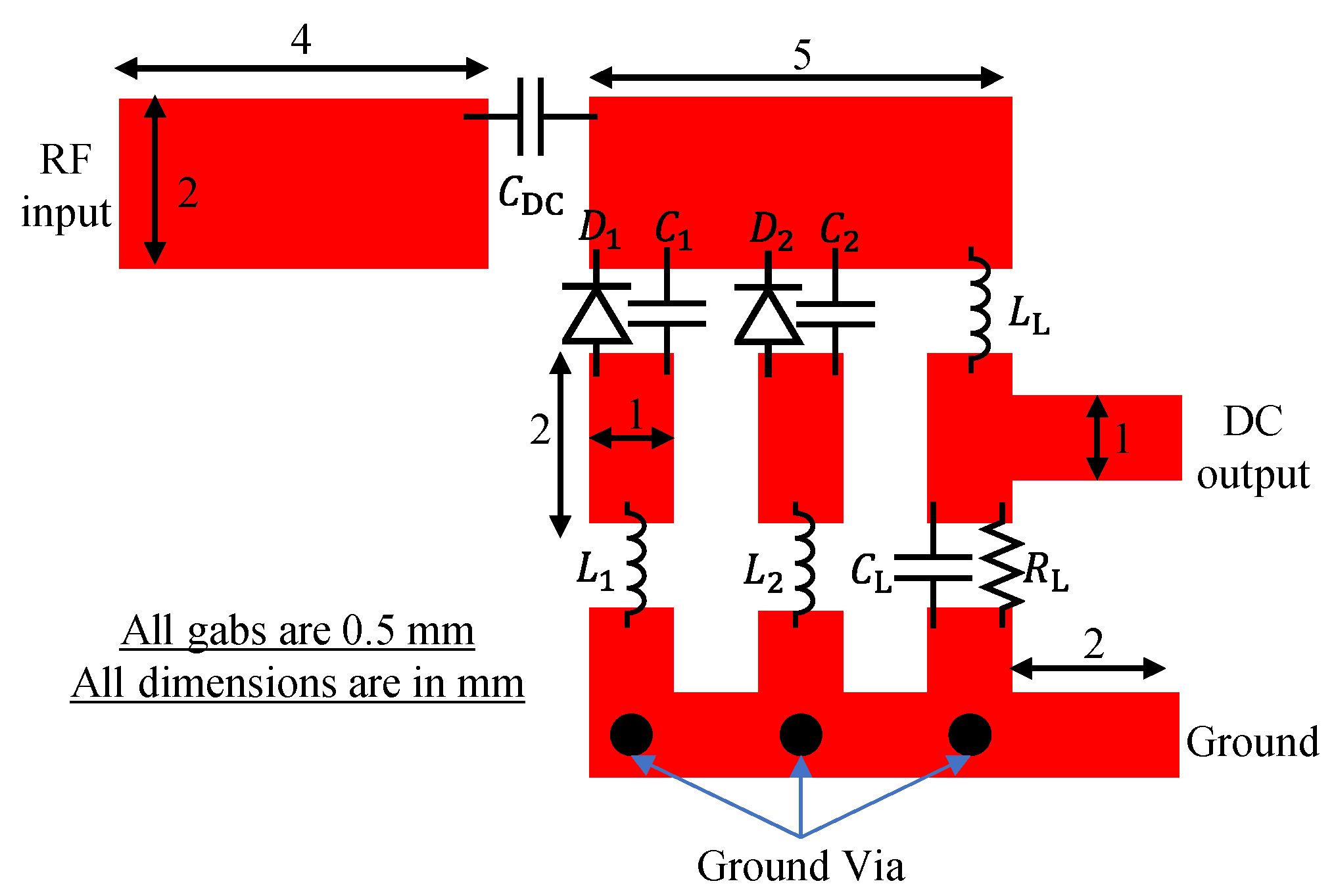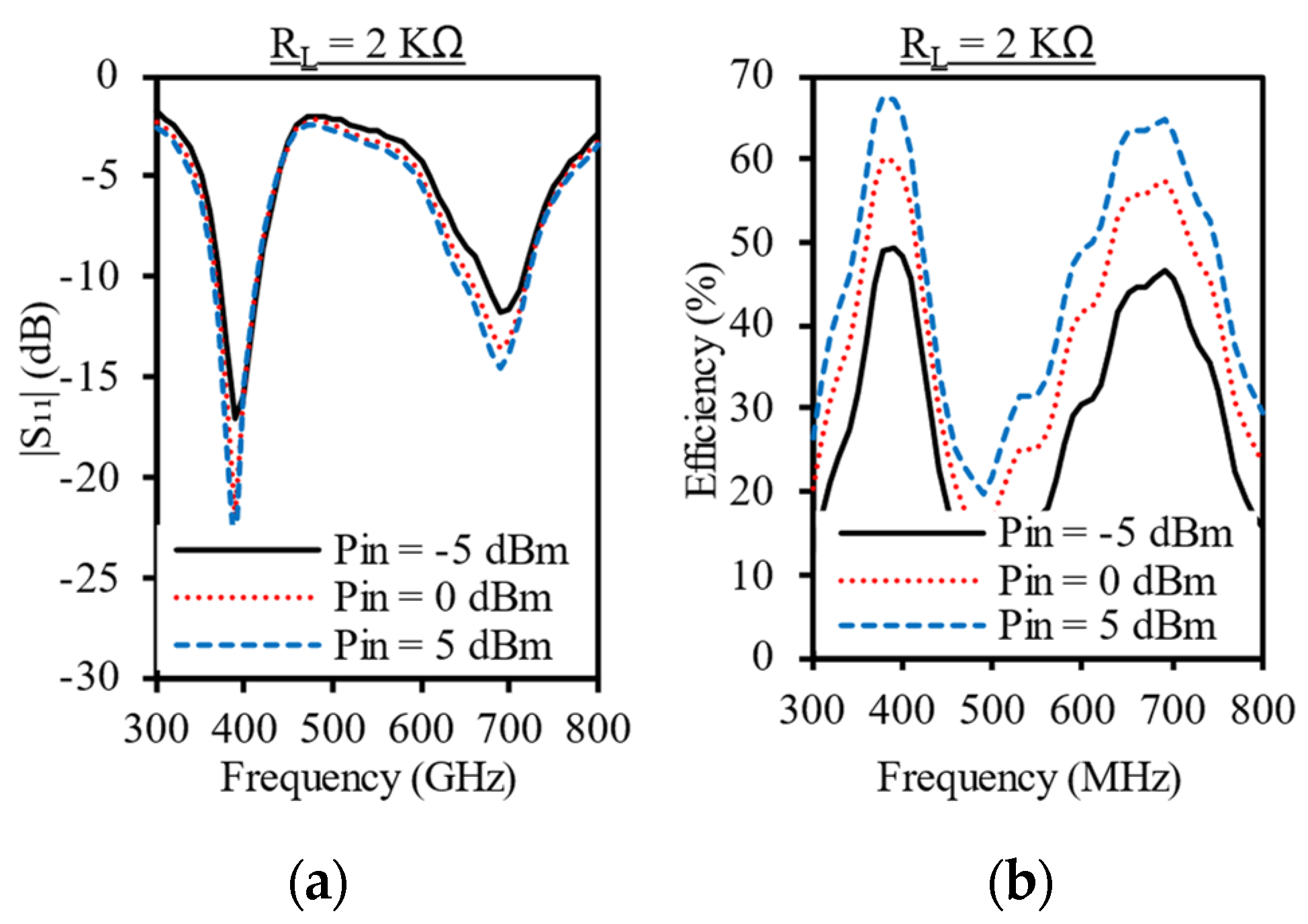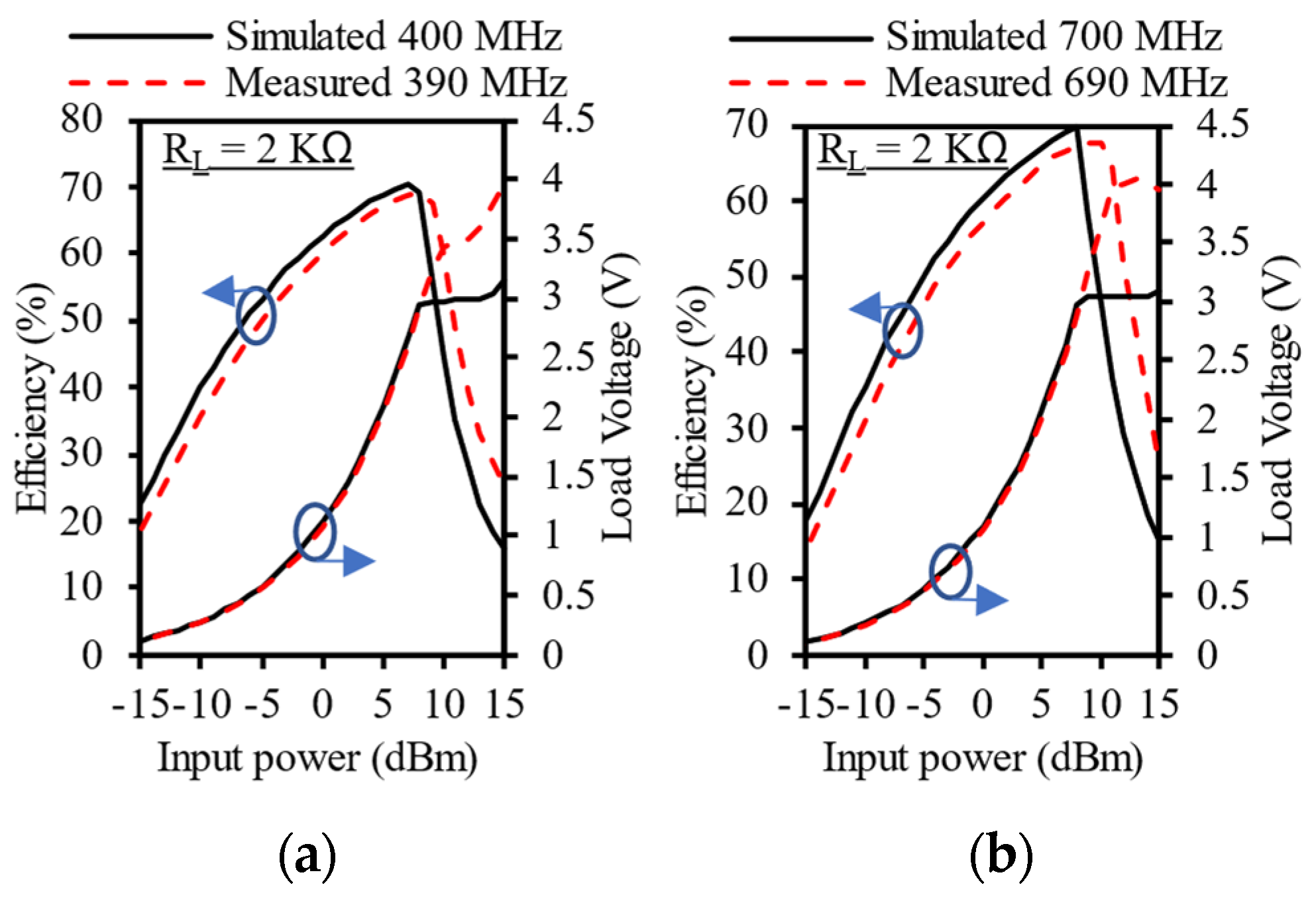Compact Dual-Band Rectifier with Self-Matched Branches Using Comprehensive Impedance Control
Abstract
1. Introduction
2. Proposed Technique
2.1. Analysis
2.2. Design Example of a Dual-Band Rectifier
3. Fabrication and Measurement Results
3.1. Fabrication and Measurement Setup
3.2. Measurement Results
3.3. Performance Comparison
4. Discussion
5. Conclusions
Author Contributions
Funding
Data Availability Statement
Conflicts of Interest
Abbreviations
| WPT | Wireless Power Transfer |
| IoT | Internet of Things |
| PCE | Power Conversion Efficiency |
| BW | Bandwidth |
| ADS | Advanced Design System |
| Q-factor | Quality Factor |
References
- Deng, X.; Yang, P.; Chen, S.; Ren, W. Design of a 2.4 & 5.8 GHz Efficient Circularly Polarized Rectenna for Wireless Power Transfer Applications. Electronics 2023, 12, 2645. [Google Scholar] [CrossRef]
- Mansour, M.M.; Torigoe, S.; Yamamoto, S.; Kanaya, H. Compact and Simple High-Efficient Dual-Band RF-DC Rectifier for Wireless Electromagnetic Energy Harvesting. Electronics 2021, 10, 1764. [Google Scholar] [CrossRef]
- Nam, H.; Bui, G.T.; Nguyen, D.A.; Seo, C. A Compact and High-Efficiency 0.915/2.45/5.8 GHz Triple-Band Rectifier with Harmonic Suppression Based on Coupled Transmission Line. IEEE Trans. Circuits Syst. II Express Briefs 2024, 71, 3553–3557. [Google Scholar] [CrossRef]
- Woo, K.; Bui, G.T.; Nguyen, D.A.; Seo, C. A Compact and High-Efficiency Design of Triple-Band Rectifier with Harmonic Suppression for Wireless Power Transfer. IEEE Microw. Wirel. Technol. Lett. 2024, 34, 111–114. [Google Scholar] [CrossRef]
- Du, C.H.; Cheng, F.; Gu, C. Efficient Tri-Band Rectifier Using Multistub Matching Network for WPT Applications. IEEE Microw. Wirel. Technol. Lett. 2023, 33, 1361–1364. [Google Scholar] [CrossRef]
- Yue, Z.; Xu, X.; Li, S.; Zhu, Y.H.; Lin, X.Q. Efficient and Compact Tri-Band Rectifier with Large Frequency Ratio for WPT. IEEE Microw. Wirel. Compon. Lett. 2022, 32, 1355–1358. [Google Scholar] [CrossRef]
- Tafekirt, H.; Pelegri-Sebastia, J.; Bouajaj, A.; Reda, B.M. A Sensitive Triple-Band Rectifier for Energy Harvesting Applications. IEEE Access 2020, 8, 73659–73664. [Google Scholar] [CrossRef]
- Wang, S.H.; Zheng, S.Y.; Leung, K.W.; Xia, M.H. A Self-Matched Multi-Band Rectifier for Efficient Electromagnetic Energy Harvesting. IEEE Trans. Circuits Syst. I Regul. Pap. 2021, 68, 4556–4565. [Google Scholar] [CrossRef]
- Liu, J.; Huang, M.; Du, Z. Design of Compact Dual-Band RF Rectifiers for Wireless Power Transfer and Energy Harvesting. IEEE Access 2020, 8, 184901–184908. [Google Scholar] [CrossRef]
- Shen, S.; Zhang, Y.; Chiu, C.Y.; Murch, R. A Triple-Band High-Gain Multibeam Ambient Rf Energy Harvesting System Utilizing Hybrid Combining. IEEE Trans. Ind. Electron. 2020, 67, 9215–9226. [Google Scholar] [CrossRef]
- Song, C.; Huang, Y.; Zhou, J.; Carter, P.; Yuan, S.; Xu, Q.; Fei, Z. Matching Network Elimination in Broadband Rectennas for High-Efficiency Wireless Power Transfer and Energy Harvesting. IEEE Trans. Ind. Electron. 2017, 64, 3950–3961. [Google Scholar] [CrossRef]
- Liu, J.; Zhang, X.Y.; Yang, C.L. Analysis and Design of Dual-Band Rectifier Using Novel Matching Network. IEEE Trans. Circuits Syst. II Express Briefs 2018, 65, 431–435. [Google Scholar] [CrossRef]
- Song, C.; Huang, Y.; Carter, P.; Zhou, J.; Yuan, S.; Xu, Q.; Kod, M. A Novel Six-Band Dual CP Rectenna Using Improved Impedance Matching Technique for Ambient RF Energy Harvesting. IEEE Trans. Antennas Propag. 2016, 64, 3160–3171. [Google Scholar] [CrossRef]
- Bougas, I.D.; Papadopoulou, M.S.; Boursianis, A.D.; Nikolaidis, S.; Goudos, S.K. Dual-Band Rectifier Circuit Design for IoT Communication in 5G Systems. Technologies 2023, 11, 34. [Google Scholar] [CrossRef]
- Liu, Y.; Xie, G. A Compact Broadband Rectifier Based on Coupled Transmission Line for Wireless Power Transfer. Electronics 2024, 13, 3901. [Google Scholar] [CrossRef]
- Gyawali, B.; Aboualalaa, M.; Barakat, A.; Pokharel, R.K. Design of Miniaturized Sub-6 GHz Rectifier with Self-Impedance Matching Technique. IEEE Trans. Circuits Syst. I Regul. Pap. 2024, 71, 3413–3422. [Google Scholar] [CrossRef]
- Xiao, Y.Y.; Ou, J.H.; Bo, S.F.; Che, W.; Zhang, X.Y. A Simple Technology for Designing Ultrawideband Rectifiers. IEEE Trans. Microw. Theory Tech. 2024, 72, 1424–1432. [Google Scholar] [CrossRef]
- Yu, S.; Cheng, F.; Gu, C.; Wang, C.; Huang, K. Compact and Efficient Broadband Rectifier Using T-Type Matching Network. IEEE Microw. Wirel. Compon. Lett. 2022, 32, 587–590. [Google Scholar] [CrossRef]
- Gyawali, B.; Thapa, S.K.; Barakat, A.; Yoshitomi, K.; Pokharel, R.K. Analysis and Design of Diode Physical Limit Bandwidth Efficient Rectification Circuit for Maximum Flat Efficiency, Wide Impedance, and Efficiency Bandwidths. Sci. Rep. 2021, 11, 19941. [Google Scholar] [CrossRef] [PubMed]
- Liu, W.; Huang, K.; Wang, T.; Zhang, Z.; Hou, J. A Broadband High-Efficiency RF Rectifier for Ambient RF Energy Harvesting. IEEE Microw. Wirel. Compon. Lett. 2020, 30, 1185–1188. [Google Scholar] [CrossRef]
- He, Z.; Liu, C. A Compact High-Efficiency Broadband Rectifier with a Wide Dynamic Range of Input Power for Energy Harvesting. IEEE Microw. Wirel. Compon. Lett. 2020, 30, 433–436. [Google Scholar] [CrossRef]
- Wu, P.; Huang, S.Y.; Zhou, W.; Yu, W.; Liu, Z.; Chen, X.; Liu, C. Compact High-Efficiency Broadband Rectifier with Multi-Stage-Transmission-Line Matching. IEEE Trans. Circuits Syst. II Express Briefs 2019, 66, 1316–1320. [Google Scholar] [CrossRef]
- Zheng, S.; Liu, W.; Pan, Y. Design of an Ultra-Wideband High-Efficiency Rectifier for Wireless Power Transmission and Harvesting Applications. IEEE Trans Ind. Inf. 2019, 15, 3334–3342. [Google Scholar] [CrossRef]
- Huang, M.; Lin, Y.L.; Ou, J.H.; Zhang, X.Y.; Lin, Q.W.; Che, W.; Xue, Q. Single-and Dual-Band Rf Rectifiers with Extended Input Power Range Using Automatic Impedance Transforming. IEEE Trans. Microw. Theory Tech. 2019, 67, 1974–1984. [Google Scholar] [CrossRef]
- Wu, P.; Huang, S.Y.; Zhou, W.; Liu, C. One Octave Bandwidth Rectifier with a Frequency Selective Diode Array. IEEE Microw. Wirel. Compon. Lett. 2018, 28, 1008–1010. [Google Scholar] [CrossRef]
- Lin, Y.L.; Zhang, X.Y.; Du, Z.X.; Lin, Q.W. High-Efficiency Microwave Rectifier with Extended Operating Bandwidth. IEEE Trans. Circuits Syst. II Express Briefs 2018, 65, 819–823. [Google Scholar] [CrossRef]
- Mansour, M.M.; Kanaya, H. Compact and Broadband RF Rectifier with 1.5 Octave Bandwidth Based on a Simple Pair of L-Section Matching Network. IEEE Microw. Wirel. Compon. Lett. 2018, 28, 335–337. [Google Scholar] [CrossRef]
- DeLong, B.J.; Kiourti, A.; Volakis, J.L. A Radiating Near-Field Patch Rectenna for Wireless Power Transfer to Medical Implants at 2.4 GHz. IEEE J. Electromagn. RF Microw. Med. Biol. 2018, 2, 64–69. [Google Scholar] [CrossRef]
- Jordan, W.; Barakat, A.; Gyawali, B.; Pokharel, R.K. High-Efficiency Platinum-Band CMOS Rectifier Using Modified Body-Biasing Technique. IEEE Microw. Wirel. Technol. Lett. 2024, 34, 1290–1292. [Google Scholar] [CrossRef]
- Gao, L.; Lin, T.W.; Rebeiz, G.M. Design of Tunable Multi-Pole Multi-Zero Bandpass Filters and Diplexer with High Selectivity and Isolation. IEEE Trans. Circuits Syst. I Regul. Pap. 2019, 66, 3831–3842. [Google Scholar] [CrossRef]









| Element | Value | Unit | Part Number |
|---|---|---|---|
| - | - | SMS7621-079LF | |
| 56 | pF | GQM1875C2E560FB12 | |
| 82 | nH | LQW15AW82NG80 | |
| 36 | nH | LQW15AN36NG8Z | |
| 1.3 | pF | GJM1555C1H1R3WB01 | |
| 0.8 | pF | GJM1555C1HR80WB01D | |
| 120 | nH | LQW15ANR12J00 | |
| 56 | pF | GQM1875C2E560FB12 | |
| 2 | KΩ | - |
| Reference | Bands | Frequency (GHz) | (%) @ (dBm) | Dynamic Range (dBm) * | Diode | Size (cm2) | |
|---|---|---|---|---|---|---|---|
| PCE > 50% | PCE > 60% | ||||||
| This work | 2 | 0.39 | 69 @ 8 dBm | −5.5 to 11 | 0 to 10 | SMS7621 | 0.42 |
| 0.69 | 68 @ 8.5 dBm | −4 to 12 | 1 to 11 | ||||
| [3] | 3 | 0.895 | 79.9 @ 9.5 dBm | −5 to 13.5 | −1.5 to 12.5 | BAT15-03W | 15 |
| 2.38 | 74.6 @ 11 dBm | −3.5 to 13 | 0.5 to 12.5 | ||||
| 5.57 | 73.6 @ 13.5 dBm | 1.5 to 16 | 5 to 15.5 | ||||
| [8] | 2 | 2.38 | 67.7 @ 5 dBm | −7 to 11 | −2 to 9 | BAT15-03W | NR |
| 4.99 | 55.3 @ 5 dBm | −2.5 to 9 | NA | ||||
| 3 | 1.78 | 60.9 @ 5 dBm | −5 to 8 | 2.5 to 6 | |||
| 2.35 | 71.4 @ 5 dBm | −7 to 10 | −3 to 8.5 | ||||
| 4.97 | 54 @ 5 dBm | 0 to 7 | NA | ||||
| [9] | 2 | 0.915 | 69.2 @ −1 dBm | −11.8 to 2.5 | −6 to 1.5 | SMS7630 | 18.8 |
| 2.45 | 64.1 @ −1 dBm | −8.6 to 1.7 | −4 to −0.5 | ||||
Disclaimer/Publisher’s Note: The statements, opinions and data contained in all publications are solely those of the individual author(s) and contributor(s) and not of MDPI and/or the editor(s). MDPI and/or the editor(s) disclaim responsibility for any injury to people or property resulting from any ideas, methods, instructions or products referred to in the content. |
© 2025 by the authors. Licensee MDPI, Basel, Switzerland. This article is an open access article distributed under the terms and conditions of the Creative Commons Attribution (CC BY) license (https://creativecommons.org/licenses/by/4.0/).
Share and Cite
Barakat, A.; Jordan, W.; Pokharel, R.K. Compact Dual-Band Rectifier with Self-Matched Branches Using Comprehensive Impedance Control. Electronics 2025, 14, 933. https://doi.org/10.3390/electronics14050933
Barakat A, Jordan W, Pokharel RK. Compact Dual-Band Rectifier with Self-Matched Branches Using Comprehensive Impedance Control. Electronics. 2025; 14(5):933. https://doi.org/10.3390/electronics14050933
Chicago/Turabian StyleBarakat, Adel, Willy Jordan, and Ramesh K. Pokharel. 2025. "Compact Dual-Band Rectifier with Self-Matched Branches Using Comprehensive Impedance Control" Electronics 14, no. 5: 933. https://doi.org/10.3390/electronics14050933
APA StyleBarakat, A., Jordan, W., & Pokharel, R. K. (2025). Compact Dual-Band Rectifier with Self-Matched Branches Using Comprehensive Impedance Control. Electronics, 14(5), 933. https://doi.org/10.3390/electronics14050933





